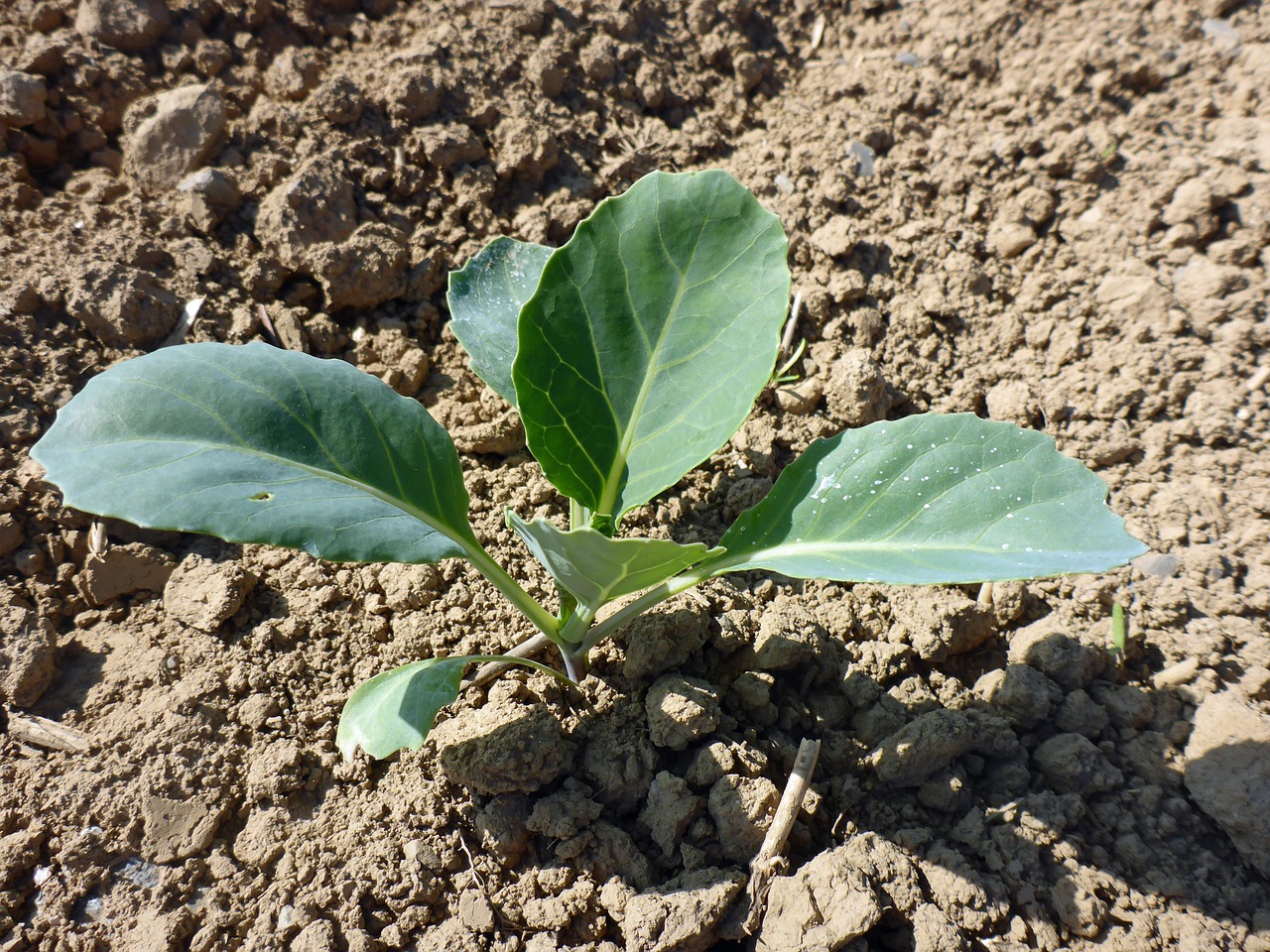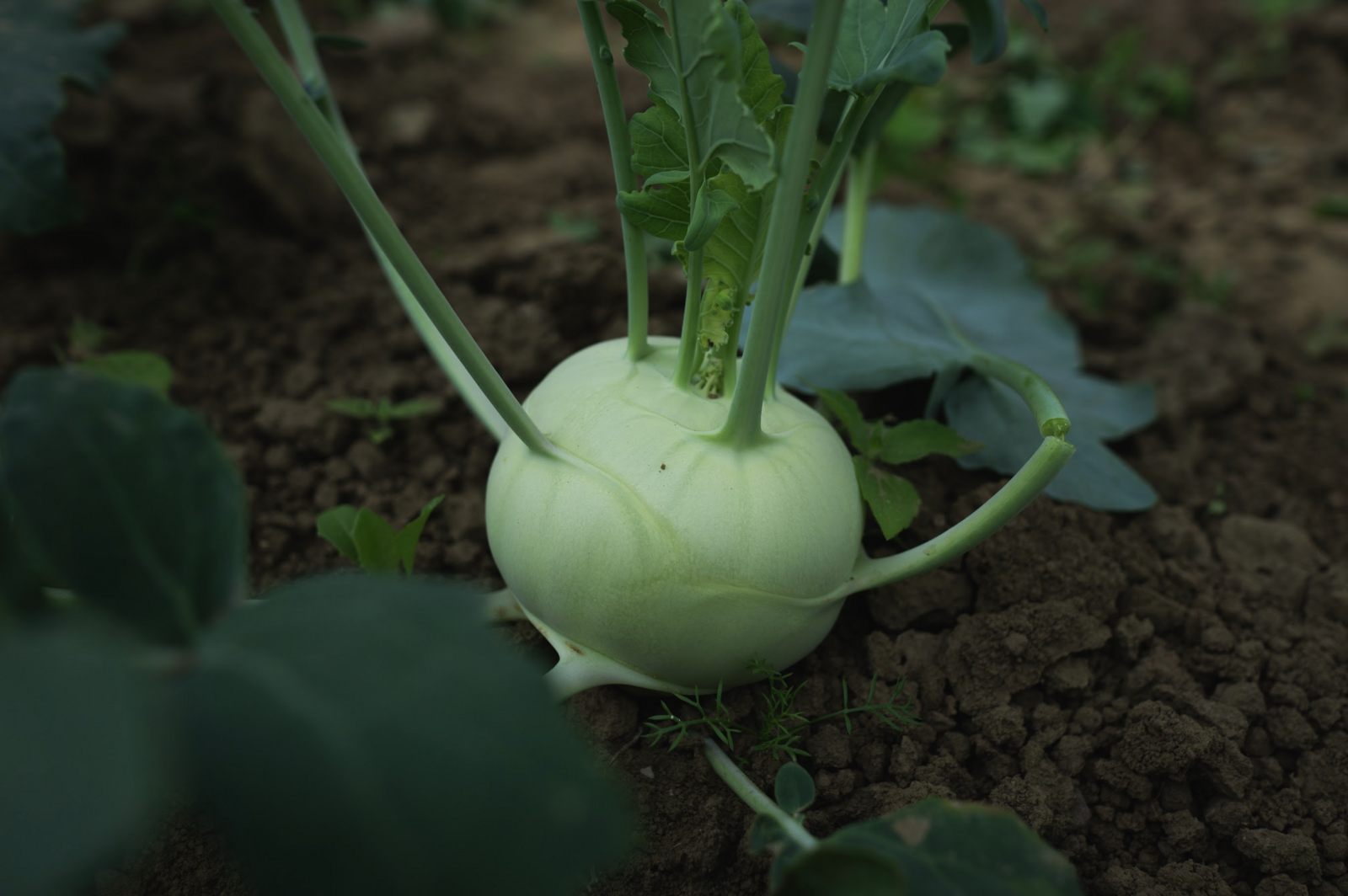
Growing Kohlrabi in Raised Beds and the Garden
Kohlrabi is the most uncomplicated cabbage plant and can be used as a catch crop. Smaller varieties are also ideal for filling gaps in the bed, as they get on well with most garden vegetables. Whether raw or cooked - they can be used in a variety of ways in the kitchen. Find out how to integrate kohlrabi into your garden and get a successful harvest here.
This Article Contains:
- Growing Kohlrabi - What You Need to Know
- Kohlrabi: Location & Soil
- Sowing Kohlrabi - Here's How
- When to Plant Kohlrabi?
- Kohlrabi in a Raised Bed
- Mixed Culture With Kohlrabi
- Bed Plans With Kohlrabi
- Fertilizing Kohlrabi
- Kohlrabi: Pests & Diseases
- Harvesting Kohlrabi - When to Harvest Kohlrabi?
- Storing Kohlrabi
- Frequently Asked Questions About Planting Kohlrabi
Quick Overview
Planting Kohlrabi: Location, Soil & Spacing
- Light: semi-shady
- Nutrient requirements: medium
- Water requirement: sufficient and even water supply, otherwise the bulb will become woody!
- Soil: rich in humus
- Germination temperature: 16 - 18 °C/60.8 - 64.4 °F
- Sowing: from February
- Planting out: from March
- Sowing depth: 1 cm/0.4 in
- Planting distance: 30 x 30 cm/ 11.8 x 11.8 in
Growing Kohlrabi - What You Need to Know
The biennial cabbage vegetable belongs to the cruciferous family (Brassicaceae) and is originally derived from wild cabbage. In the first year, the tuber is formed, which we like to use for cooking. Only the second year is used for reproduction. This produces a branched inflorescence on which pods with seeds are formed.
It is not the flower that is eaten, as with broccoli or cauliflower, but the stem. However, the young kohlrabi leaves are also very healthy due to their high iron content and are delicious in dishes such as soups, salads and vegetable stir-fries.

Kohlrabi: Location & Soil
Kohlrabi is happy with a wide range of growing conditions. As a frugal, medium-feeder, it does not need as many nutrients as other Cabbages. Nevertheless, it prefers a humus-rich and evenly moist soil. The tuber can cope with light conditions from sunny to semi-shady. Most varieties do not require a lot of space and can therefore be used as "gap fillers". However, there are also larger varieties, such as the aforementioned "Superschmelz", in which a single kohlrabi can weigh up to 8 kg/17.6 pd and still remain tender and tasty.
Sowing Kohlrabi - Here's How
If you want an early harvest, pre-cultivation is a good idea. From mid-February to early March, kohlrabi can be pre-cultivated in seed trays on the windowsill. The germination temperature is around 16 - 18 °C/60.8 - 64.4 °F, so you should not choose a place that is too cold. Once the seedlings have germinated, they like it rather cool (but not below 12 °C/53.6 °F). If the seedlings are too close together, You Should Prick Out Your Kohlrabi Seedlings If you are aiming for a later harvest, you can sow and propagate until the beginning of July.
Our tip: Always sow staggered so that you can harvest fresh kohlrabi throughout the season. Because if the tubers stand too long, they start to become woody.
When to Plant Kohlrabi?

You can plant the first seedlings in your bed from the end of March. If you want to be on the safe side, wait until the beginning of April. Be careful not to plant the plants too deep, otherwise the kohlrabi tubers will rest on the ground and start to rot more quickly. If you harvest late, you can plant out until the beginning of August .
Kohlrabi in a Raised Bed
Kohlrabi also grows well in raised beds. As this medium-spreader copes relatively well with many conditions, there is not really too much to consider. To ensure that the tubers grow quickly, you can enrich your raised bed with fresh compost in the fall before you plant kohlrabi. This will provide the plant with sufficient nutrients. Important for the taste of the tuber: the consistency. As kohlrabi becomes woody relatively quickly if it is not supplied with an even supply of water, the following applies here: Water sufficiently. Raised beds usually dry out more quickly than normal beds on the ground. To counteract drying out, you can cover your raised bed with a layer of mulch. This protects against evaporation on hot days and keeps the soil moist for longer.
Mixed Culture With Kohlrabi
As kohlrabi are fast-growing, they are often used by knowledgeable gardeners as a catch crop. Kohlrabi can also be used as a preceding crop, as its growing season starts relatively early.
The plants can also be perfectly integrated into a Mixed Crop. There are a few things to bear in mind to avoid leaching the soil. In our article on Mixed Cultivation With Cabbage, you will find tips for sensible mixed cultivation and succession cropping with kohlrabi.

Create Your Vegetable Patch With Companion Plants
With our garden planner, you can easily plan a colorful mixed crop. Good and bad neighbors are displayed directly and you get tips on crop rotation!
Plan Your Vegetable Patch
Good and Bad Companion Plants for Kohlrabi
- Good companions: beans, peas, potatoes, lettuce, leeks, radishes, salsify, celery, asparagus, spinach, tomatoes
- Bad companions: fennel, cucumbers
Important: Do not combine the tuber with other types of cabbage, such as kale or Brussels Sprouts.
Bed Plans With Kohlrabi
Here you will find different garden designs with kohlrabi in mixed cultivation:
Fertilizing Kohlrabi
Kohlrabi is a medium feeder and therefore requires no additional fertilization. Nevertheless, it is a good idea to add a small amount of compost to the hole when planting in poor sandy soil. This not only keeps the soil more moist, but also makes it easier for the plant to get started in the open ground. Horn shavings also have a positive effect on the growth of kohlrabi.
Kohlrabi: Pests & Diseases
Caterpillar of the Cabbage White Butterfly
As with all types of cabbage, kohlrabi can be infested by the caterpillars of the Cabbage White Butterfly. Check the undersides of the leaves of your kohlrabi plants regularly, as this is where the moth attaches its eggs. The white butterfly is particularly attracted to your garden if you apply nettle slurry to strengthen your plants.
Cabbage White Butterfly Control and Prevention
You can prevent infestation by planting tomatoes and celery next to your cabbage (rabi). If you plant later in the season, you can mulch with tansy or peppermint, if available. Both plants repel the moths. However, you can prevent infestation not only biologically, but also mechanically by using crop protection nets.
However, if it is already too late and the caterpillars are already there, it is worth collecting them by hand at an early stage. You can also use parasitic wasps as beneficial insects in your garden, as they are natural enemies of the cabbage white butterfly. These biological pest controllers can be ordered from various online stores.

Cabbage Hernia in Kohlrabi
Cabbage hernia is also a typical disease of all cruciferous plants (Brassicaceae). The fungal disease causes the cabbage to grow poorly and later, even with sufficient watering, the leaves droop and turn yellow.
Combat and Prevent Cabbage Hernia
Cabbage hernia can be avoided by ensuring a balanced Crop Rotation. Take a cultivation break of around 4 years so that the soil does not become depleted and no crop-specific diseases develop. If you have symptomatic wilted cabbage plants in your garden despite the crop rotation, dig them up and check the roots. A typical symptom is tuberous thickening. To be absolutely sure that it really is the fungus, you need to cut the thick roots. If they are hollow, it is probably the cabbage gall weevil. If the roots are white and not hollow, it is most likely the cabbage hernia fungus. In both cases, you should unfortunately dispose of your plants as quickly as possible, otherwise other plants may be infested. But beware: the cabbage hernia fungus can also survive in compost and infect your plants again later.
Harvesting Kohlrabi - When to Harvest Kohlrabi?
If you have successfully grown and cared for your kohlrabi, you can harvest it after approx. 6 - 8 weeks. Your bulb should then be about the size of a tennis ball (of course, there are also larger varieties). However, you now have to make a compromise: The younger you harvest your kohlrabi, the more tender it tastes. However, if you leave it longer, it will be bigger but also less tender. It is best to harvest the bulb directly before you process it, as it will also become tougher if stored for longer. To do this, simply cut the stem directly under the bulb with a knife and remove the leaves. As mentioned above, you can also use the tender kohlrabi leaves in your dishes.

Storing Kohlrabi
If you can't eat your kohlrabi straight away, remove the leaves and wrap a damp cloth around the bulb. You can store them in the fridge like this for up to two weeks. Without the cloth, the vegetables should be processed within 2 - 6 days. You can find out more methods for Preserving Fruit and Vegetables here.
We hope you now feel ready to get into the kohlrabi business and wish you a naturally successful harvest!
What experiences have you had with cabbage cultivation? Feel free to share them with us on social media or at [email protected].
Want to get helpful gardening tips all year round and plan your own beds in the best possible way? Then register here or download the Fryd app for Android or iOS.
Fryd - Your digital bed planner

Isabell
Isabell studies agricultural sciences and loves to be surprised by nature and its complexity again and again. Herbs - whether gathered wild or in the garden - are her passion.
Learn MoreCurrent Topics in the Community


My homemade beeswax candles made from my own beeswax Now the problem is that I can no longer reach my vegetables - even the digging fork is frozen solid - I can only harvest Brussels sprouts and kale

Liked 2 times
After two weeks, the turmeric rhizome shows the first signs of life. #turmeric #spices

Liked 2 times
The raised bed 1x5m is small wood. A 2.5x3m greenhouse is now to be built here in spring 26. What is your tip? Replace the soil with new soil and plant directly? Or pave it out and use raised beds again?
Show 1 answerPopular Articles

Overwintering Parsley: How to Do It Successfully

How to Grow Lettuce in Winter: Varieties, Sowing, Harvesting

Growing Sage Plant: Tips for Sowing and Harvesting

What Herbs Can Be Planted Together?

Create & Design a Permaculture Garden

Overwintering Plants: Tubs, Pots and Raised Beds

Pruning, Fertilizing & Propagating Currants: Care Tips

Pruning Raspberries: How to Do It

Vegetable Garden With Greenhouse: How to Use Greenhouse Effect

Winterizing Beds and the Garden: How to Do It
FAQ
Can you grow kohlrabi in a raised bed?
Kohlrabi can be grown well in raised beds. Protect the soil with an additional layer of mulch to prevent it from drying out. Kohlrabi plants need evenly moist soil.
When to plant kohlrabi in the raised bed?
You can plant your young kohlrabi plants in the bed from the end of March to the beginning of August. Do not plant the plants too deep into the soil, otherwise they may rot.
When should you start propagating kohlrabi?
You can start growing between February and March. This gives the plants a head start on growth and allows you to harvest earlier.
After around two to three months, the kohlrabi is ready to harvest. With staggered sowing, you can grow your own kohlrabi almost all year round. Depending on the variety, the tuber should be about the size of a tennis ball when ready to harvest.